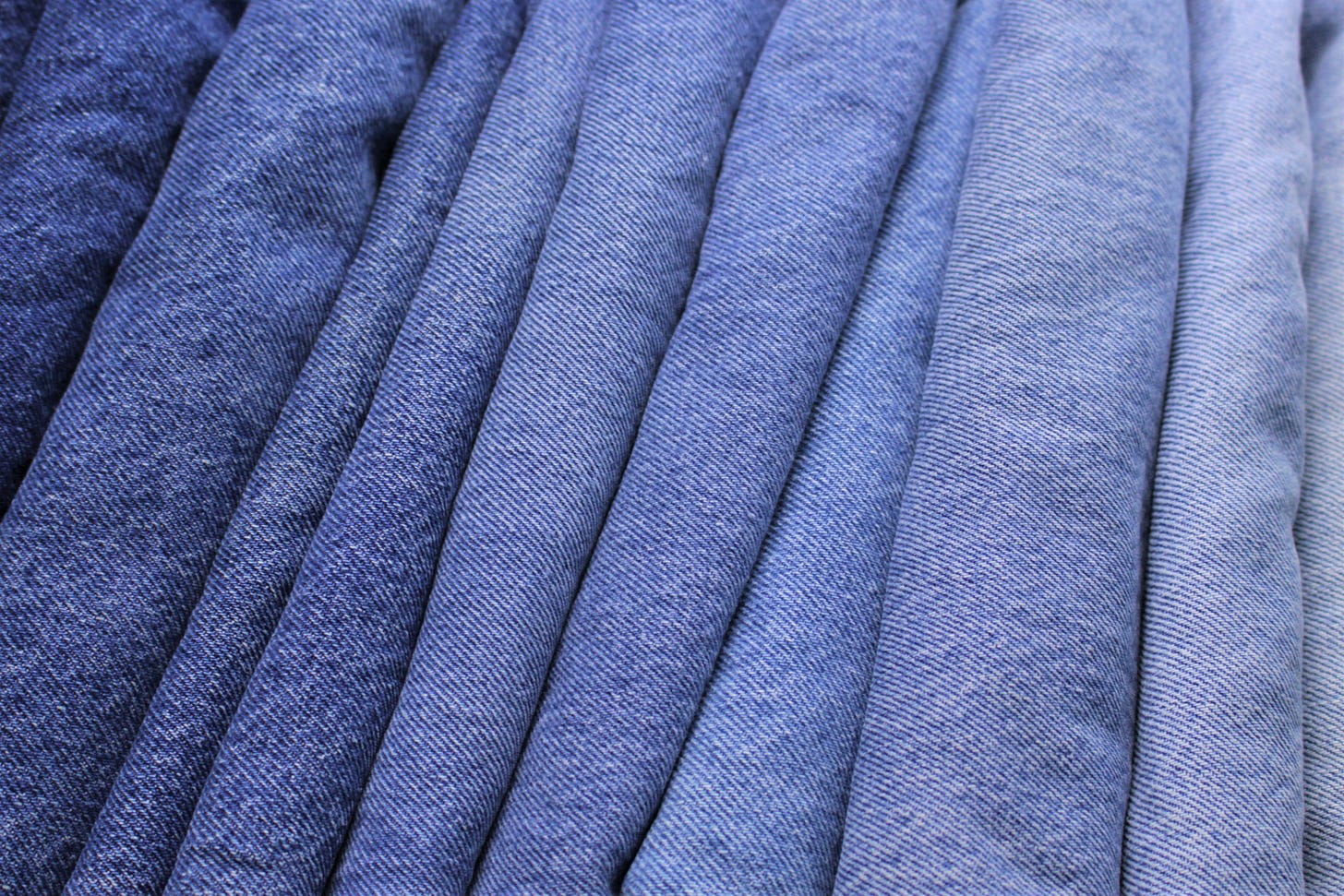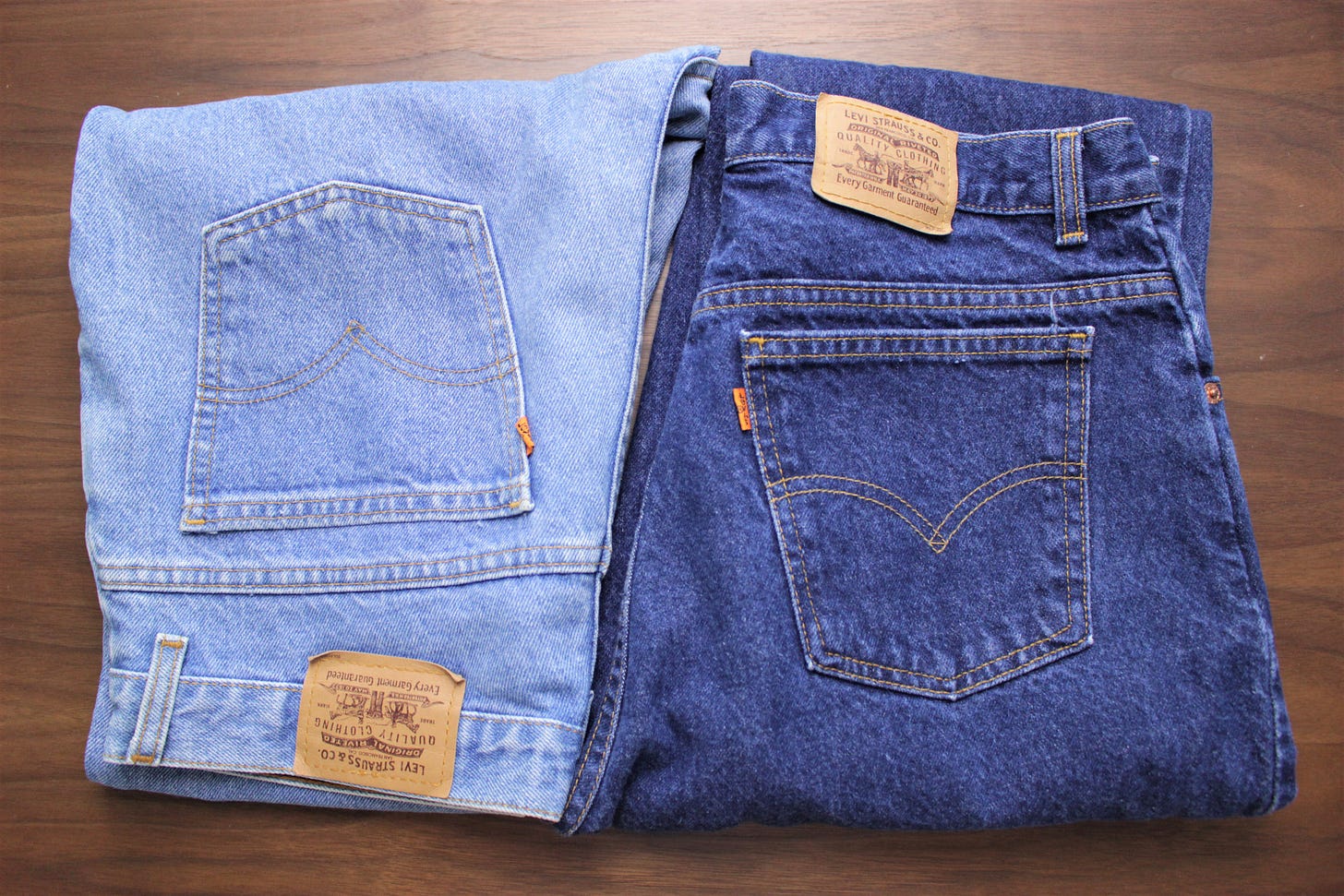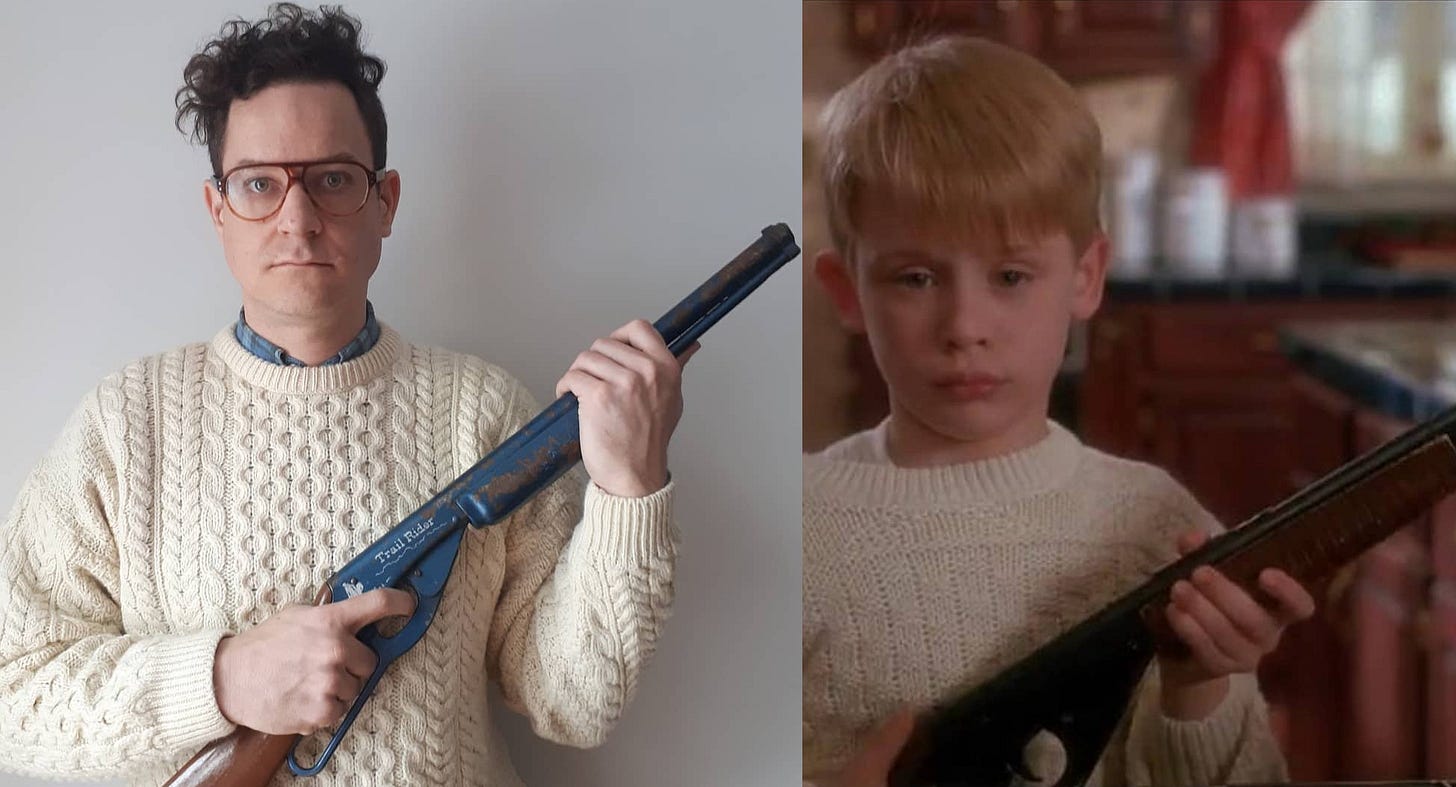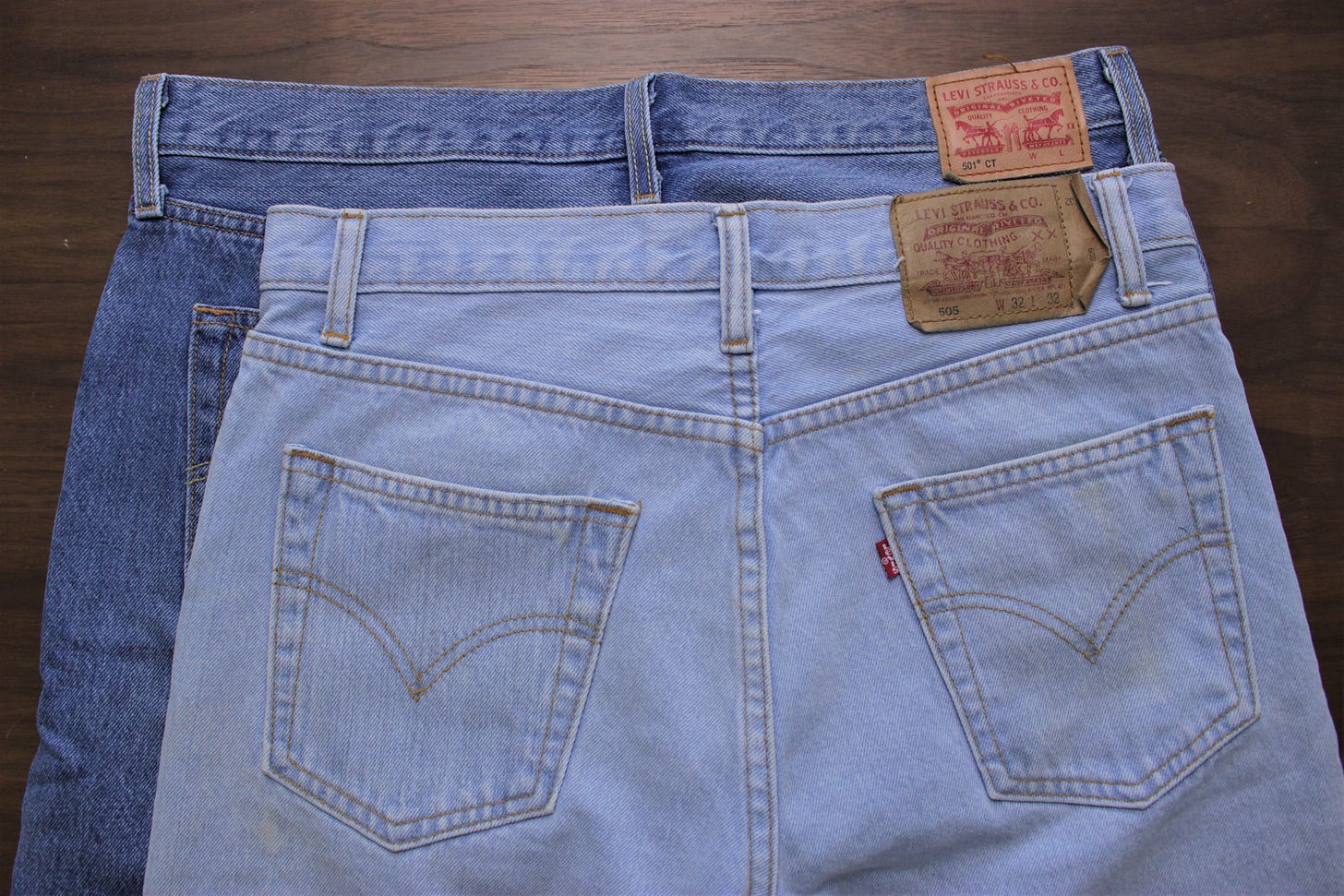
From my late teens through to my mid 30s, I rarely wore jeans. The biggest factor was probably a lifelong nonconformist streak, which in retrospect is dryly ironic considering blue jeans’ status as a symbol of youthful rebellion for the postwar generation. But by the time I was growing up, blue jeans were the default, conformist choice. I’d developed what I believed an elegant syllogism of contrarian logic: Normies wear jeans, I am not a Normie, ergo I don’t wear jeans. The other part, which I understood intuitively but couldn’t name at the time, was that jeans just didn’t fit my body well; at least not the sort of jeans you could get at Southcentre Mall in the early 2000s.
Surely that hadn’t always been the case, had it? It’s unlikely that I spent a lot of time in childhood pondering the fit of my jeans (though not outside the realm of possibility, I was a weird kid), but surely I’d have noticed if my pants hadn’t covered my ass half the time, right? But, like finding out Brussels Sprouts really did taste worse when we were young, I came to understand it wasn’t me that had changed, but the world around me. Through a combination of vanity sizing and slim/skinny fits becoming the default, jeans really did fit differently!
Clothing manufacturers began the practice of “vanity sizing,” inflating the measured dimensions of a given alphanumeric size, as early as 1958. That year, the average measured waist of a size 12 women’s garment was 25 inches. By 1970 it was 26”, by 2001 it had grown to 29” and in 2011 it was just over 32 inches! Based on my own experiences selling hundreds of pairs of vintage pants, I assumed the vanity sizing trend had begun around the mid-late 1990s; turns out this was about the time it hit menswear.
The changing standards of white-collar and creative-class business dress from the 1960s to the 1990s may have played a part in menswear’s delayed adoption of vanity sizing. Postwar through most of the 1980s, business dress still largely meant suits. Even an off-the-rack suit still needs some tailoring; older generations of men may have had a better awareness of their body’s sizing from even those limited interactions with a tailor, and as consumers would expect something tagged their measured size to fit properly. But then again, even assuming most men did their own shopping in that era is a leap, isn’t it? It makes sense that a homemaker who did the shopping and alterations for her family would also know their measurements and expect something tagged in those measured sizes to fit, but by that logic vanity sizing never should have taken hold in womenswear either. Strange world!
In any event, the widespread adoption of Business Casual dress codes* in the 1990s ultimately meant a shift in white-collar men’s wardrobes away from tailored elements and into ready-to-wear casual sportswear looks. This, coupled this with shifting gender roles and familial expectations, as well as fewer taboos around divorce, meant more men than ever before were doing their own shopping. Ultimately this would not only change how men’s clothing was sized, but how it was marketed as well; turns out women aren’t the only ones with anxieties about their bodies!
The mainstreaming of slim and skinny fits in the early-mid 2000s was another major shift in menswear. A lean silhouette made sense as both a logical counterpoint to the power-shouldered superhero shapes and oversized, soft drape cuts of the 1980s and 1990s, as well as an evolution of the minimal tailoring designers like Calvin Klein and Jil Sander built their reputations on during that same period. Hedi Slimane’s turn at Dior in the mid-2000s popularized an ultra-slim silhouette, which trickled down, as all things do, to fast fashion. So waistbands got wider and lower as everything else got slimmer and shorter, with the result that men’s pants now are cut much more like women’s.
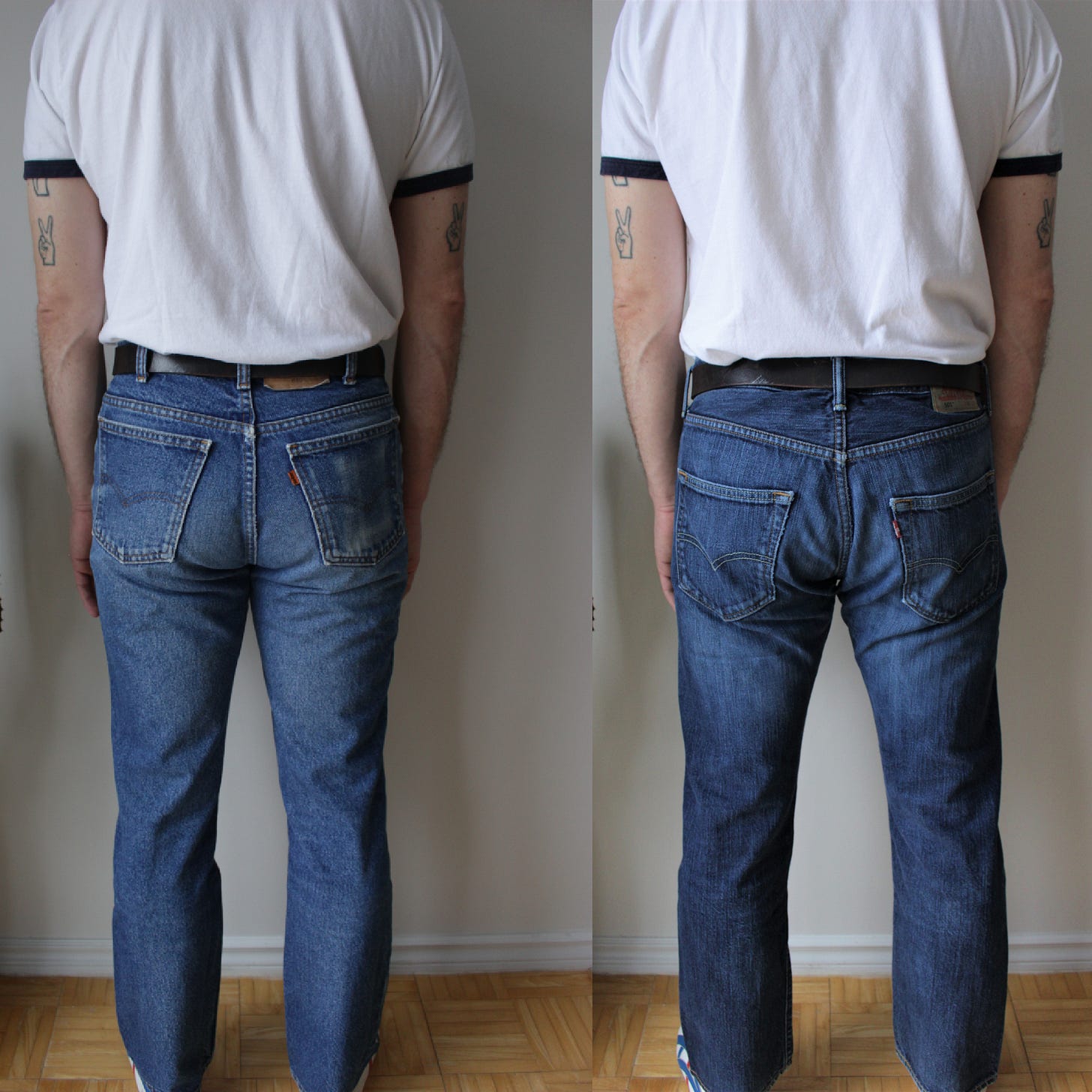
The charitable explanation for the size disparity at the top of this post is that the newer pair are supposed to be worn low-slung, so the “waist” measurement is actually a hip measurement. The cynical one is that media and marketing in fashion, fitness, food and dieting prey on insecurities about body image in two seemingly opposing ways: presenting impossibly thin or athletic bodies, that is to say, bodies belonging to people who are probably fastidious about what they eat, as the ideal to aspire to, while simultaneously marketing the act of eating itself as a glamourous and sexualized one with these same sorts of bodies and images. No wonder so many people try to replace sex and romance with food! In the past, these messages were primarily aimed at women; society has since learned to harness the body anxieties of all genders to drive consumption. Progress!
What’s really being sold is the idea that you can buy instant self-confidence, so of course consumer goodwill and brand loyalty can be generated by vanity sizing! Who wouldn’t feel more confident in the pair of pants with the same waist size they wore in highschool? But why is that? What does it tell us about the way we view ourselves and others? If confidence is self-worth, then surely what we value in ourselves reflects what we value in others; if my sense of worthiness is linked to the waist size on my jeans, what does that tell me about my beliefs, conscious or otherwise, about other people and their waist sizes? Who put all these beauty standards in my brain?
* “Business Casual” being so amorphous and nebulous that it’s perhaps best defined through Potter Stewart’s famous maxim on obscenity, “I know it when I see it.”
The Fresh Eye Twitch Stream
On Boxing Day I hosted a little holiday style stream where I broke down the wardrobe and styling choices in Home Alone and what they tell us about the characters. It’s a really interesting movie to look at through a fashion lens; it has excellent styling and does a really great job of characterization through the visual language of clothing, especially for minor characters. I also talked about Fresh Prince S2E13 “Christmas Show,” which is a parade of exemplary 1990s apres-ski style, and the distinctly Canadian outerwear choices on the Trailer Park Boys Christmas special. You can check out the show on my Twitch page, and tune in Saturdays at 3 ET for more movies & TV with running style commentary.
Thanks for reading. I know from experience that the world of fashion and style can be scary and off-putting, especially for people who feel like their bodies don’t belong. When we don’t see ourselves represented, caring about clothing can feel like a frivolous pursuit for the shallow. I believe that finding and expressing yourself through your personal style is truly a transformative process that everyone can benefit from; it seems counterintuitive, but it really is “inner work.” So if you’ve ever wanted to learn more about fashion and style but felt intimidated, I’d love to help you discover yourself through discovering your style. Book a free 30-minute Style Goals consult via email or through my website today.
Jordan Lane, CMIC
Fresh Eye Image Consulting
thefresheye.net
linktr.ee/thefresheye



